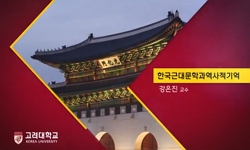The appearance of Chinese poems of the Tang Dynasty style by three poets in the Joseon Dynasty(三唐詩) that accepted the Tang poetry during its flourishing period(盛唐詩) became the turning point of Korean literary history. Trends of new tendenc...
http://chineseinput.net/에서 pinyin(병음)방식으로 중국어를 변환할 수 있습니다.
변환된 중국어를 복사하여 사용하시면 됩니다.
- 中文 을 입력하시려면 zhongwen을 입력하시고 space를누르시면됩니다.
- 北京 을 입력하시려면 beijing을 입력하시고 space를 누르시면 됩니다.

당풍(唐風) 수용기 정용(鄭鎔)의 한시(漢詩)에 대한 고찰 -시선집(詩選集)에 수록된 작품을 중심으로 = A study on Chinese poems of Jeong Yong(鄭鎔) in Acceptance Era with the Tang Dynasty`s poem styles -Focusing on the works of art in the anthology of poetry(詩選集)
한글로보기https://www.riss.kr/link?id=A104180784
- 저자
- 발행기관
- 학술지명
- 권호사항
-
발행연도
2016
-
작성언어
-
- 주제어
-
KDC
800
-
등재정보
KCI등재
-
자료형태
학술저널
- 발행기관 URL
-
수록면
123-152(30쪽)
- 제공처
-
0
상세조회 -
0
다운로드
부가정보
다국어 초록 (Multilingual Abstract)
Joeng Yong(鄭鎔) is the figure who participated in the period that the three poets who wrote the Tang Dynasty`s Chinese poem styles were active as the poet who has never been known to us in the meanwhile.
He devoted himself to writing his poems by communing with nature without entering government service despite the background of his distinguished family and economic affluence as the descendant of Jeong Mi-su(鄭眉壽) who was raised to Haepyeongbuwongun(海平府院君) as Jeonggukgongsin(靖國功臣). He did not leave many works of art. However, he can be evaluated to account for a considerable proportion of the period as Heo Gyun put his 6 poems in Gukjosisan(國朝詩刪) and included stores about his poems in Haksanchodam(鶴山樵談) and Seongsobugo(惺所覆?藁) by thinking highly of him.
He expressed his thoughts by accepting the Tang Dynasty`s Chinese poem styles. Sometimes, he shows unpracticed works of art. However, his works of art usually feature simple expressions of the scenery of the seasons around him and his mind and thought as he gave preference to quatrain forms. Heo Gyun introduced his partial works of art about the vast and ornate scenery written by him because of a kind of spells that he felt a disposition to do them(詩魔) to people. It is clear that they were written by Jeong, Yong`s mouth even though they are not linked to his other works of art about the simple scenery. Jeong, Yong`s light and simple Chinese poems can somewhat be meaningful from an angle that the Tang Dynasty`s Chinese poem styles settled and were popular in the middle of the Jonseon Dynasty. In addition, discussion on various poetical styles by many poets who were not known then will be a clue to understand acceptance of the Tang Dynasty`s Chinese poem styles widely.
The appearance of Chinese poems of the Tang Dynasty style by three poets in the Joseon Dynasty(三唐詩) that accepted the Tang poetry during its flourishing period(盛唐詩) became the turning point of Korean literary history. Trends of new tendencies in literary history cannot be done by several writers` efforts and model(典範)`s logic and directivity get to settle in the process that many poets who are active then associate with each other and participate. However, except the three poets who wrote the Tang Dynasty`s Chinese poem styles, discussion on several poets who were active in this period are desperately lacking.
Joeng Yong(鄭鎔) is the figure who participated in the period that the three poets who wrote the Tang Dynasty`s Chinese poem styles were active as the poet who has never been known to us in the meanwhile.
He devoted himself to writing his poems by communing with nature without entering government service despite the background of his distinguished family and economic affluence as the descendant of Jeong Mi-su(鄭眉壽) who was raised to Haepyeongbuwongun(海平府院君) as Jeonggukgongsin(靖國功臣). He did not leave many works of art. However, he can be evaluated to account for a considerable proportion of the period as Heo Gyun put his 6 poems in Gukjosisan(國朝詩刪) and included stores about his poems in Haksanchodam(鶴山樵談) and Seongsobugo(惺所覆?藁) by thinking highly of him.
He expressed his thoughts by accepting the Tang Dynasty`s Chinese poem styles. Sometimes, he shows unpracticed works of art. However, his works of art usually feature simple expressions of the scenery of the seasons around him and his mind and thought as he gave preference to quatrain forms. Heo Gyun introduced his partial works of art about the vast and ornate scenery written by him because of a kind of spells that he felt a disposition to do them(詩魔) to people. It is clear that they were written by Jeong, Yong`s mouth even though they are not linked to his other works of art about the simple scenery. Jeong, Yong`s light and simple Chinese poems can somewhat be meaningful from an angle that the Tang Dynasty`s Chinese poem styles settled and were popular in the middle of the Jonseon Dynasty. In addition, discussion on various poetical styles by many poets who were not known then will be a clue to understand acceptance of the Tang Dynasty`s Chinese poem styles widely.
동일학술지(권/호) 다른 논문
-
- 한국한시학회
- 강혜선
- 2016
- KCI등재
-
- 한국한시학회
- 박수천
- 2016
- KCI등재
-
- 한국한시학회
- 안순태 ( An Soontae )
- 2016
- KCI등재
-
- 한국한시학회
- 한영규 ( Han Younggyu )
- 2016
- KCI등재




 KCI
KCI KISS
KISS


